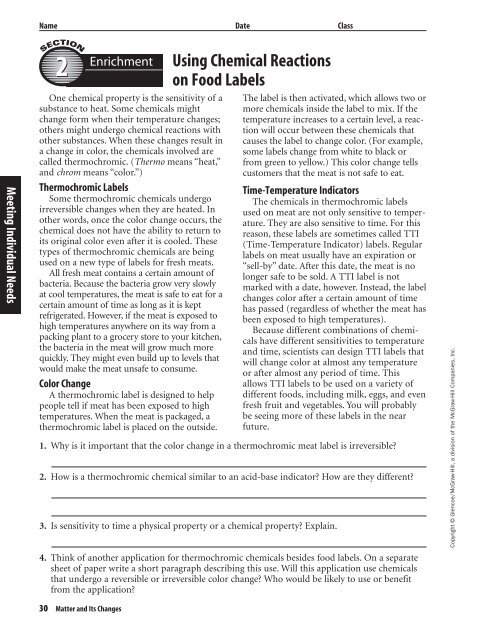Chapter 3 Resource: Matter and its Changes
Chapter 3 Resource: Matter and its Changes
Chapter 3 Resource: Matter and its Changes
Create successful ePaper yourself
Turn your PDF publications into a flip-book with our unique Google optimized e-Paper software.
Name Date Class<br />
Meeting Individual Needs<br />
2<br />
Enrichment<br />
One chemical property is the sensitivity of a<br />
substance to heat. Some chemicals might<br />
change form when their temperature changes;<br />
others might undergo chemical reactions with<br />
other substances. When these changes result in<br />
a change in color, the chemicals involved are<br />
called thermochromic. (Thermo means “heat,”<br />
<strong>and</strong> chrom means “color.”)<br />
Thermochromic Labels<br />
Some thermochromic chemicals undergo<br />
irreversible changes when they are heated. In<br />
other words, once the color change occurs, the<br />
chemical does not have the ability to return to<br />
<strong>its</strong> original color even after it is cooled. These<br />
types of thermochromic chemicals are being<br />
used on a new type of labels for fresh meats.<br />
All fresh meat contains a certain amount of<br />
bacteria. Because the bacteria grow very slowly<br />
at cool temperatures, the meat is safe to eat for a<br />
certain amount of time as long as it is kept<br />
refrigerated. However, if the meat is exposed to<br />
high temperatures anywhere on <strong>its</strong> way from a<br />
packing plant to a grocery store to your kitchen,<br />
the bacteria in the meat will grow much more<br />
quickly. They might even build up to levels that<br />
would make the meat unsafe to consume.<br />
Color Change<br />
A thermochromic label is designed to help<br />
people tell if meat has been exposed to high<br />
temperatures. When the meat is packaged, a<br />
thermochromic label is placed on the outside.<br />
Using Chemical Reactions<br />
on Food Labels<br />
The label is then activated, which allows two or<br />
more chemicals inside the label to mix. If the<br />
temperature increases to a certain level, a reaction<br />
will occur between these chemicals that<br />
causes the label to change color. (For example,<br />
some labels change from white to black or<br />
from green to yellow.) This color change tells<br />
customers that the meat is not safe to eat.<br />
Time-Temperature Indicators<br />
The chemicals in thermochromic labels<br />
used on meat are not only sensitive to temperature.<br />
They are also sensitive to time. For this<br />
reason, these labels are sometimes called TTI<br />
(Time-Temperature Indicator) labels. Regular<br />
labels on meat usually have an expiration or<br />
“sell-by” date. After this date, the meat is no<br />
longer safe to be sold. A TTI label is not<br />
marked with a date, however. Instead, the label<br />
changes color after a certain amount of time<br />
has passed (regardless of whether the meat has<br />
been exposed to high temperatures).<br />
Because different combinations of chemicals<br />
have different sensitivities to temperature<br />
<strong>and</strong> time, scientists can design TTI labels that<br />
will change color at almost any temperature<br />
or after almost any period of time. This<br />
allows TTI labels to be used on a variety of<br />
different foods, including milk, eggs, <strong>and</strong> even<br />
fresh fruit <strong>and</strong> vegetables. You will probably<br />
be seeing more of these labels in the near<br />
future.<br />
1. Why is it important that the color change in a thermochromic meat label is irreversible<br />
2. How is a thermochromic chemical similar to an acid-base indicator How are they different<br />
3. Is sensitivity to time a physical property or a chemical property Explain.<br />
4. Think of another application for thermochromic chemicals besides food labels. On a separate<br />
sheet of paper write a short paragraph describing this use. Will this application use chemicals<br />
that undergo a reversible or irreversible color change Who would be likely to use or benefit<br />
from the application<br />
Copyright © Glencoe/McGraw-Hill, a division of the McGraw-Hill Companies, Inc.<br />
30 <strong>Matter</strong> <strong>and</strong> Its <strong>Changes</strong>














